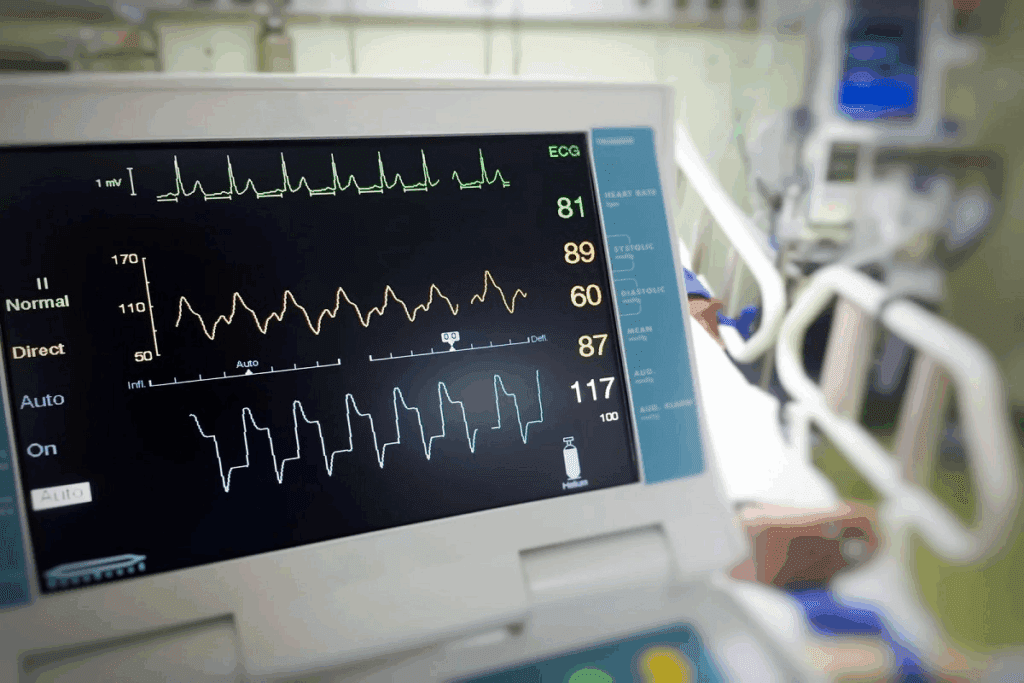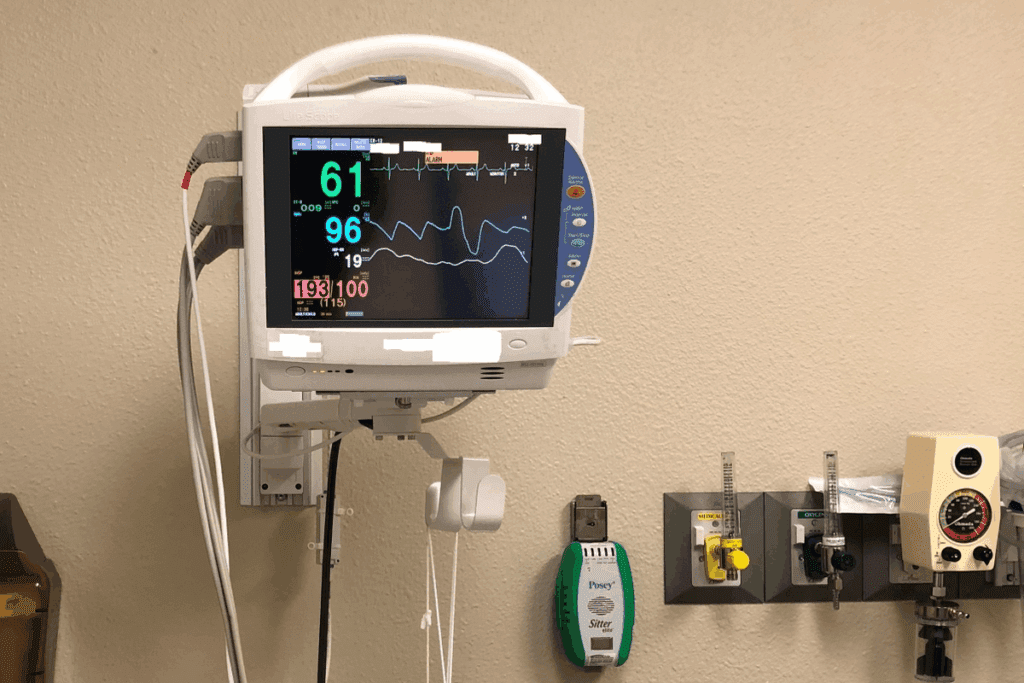Last Updated on October 31, 2025 by Batuhan Temel

Understand what is a heart monitor and how a 24-hour Holter monitor works.
At Liv Hospital, we focus on tracking heart activity to spot and handle heart problems well. A heart rate monitor is a tool that logs the heart’s beat and rhythm over time. It helps doctors find and fix irregular heartbeats and other heart issues.
A 24-hour Holter monitor is a small, easy-to-carry device. It tracks the heart’s activity for 24 to 48 hours. This gives doctors a deep look into heart health. They use this info to create treatment plans that fit each person’s needs.

Cardiac monitoring is key for spotting and treating heart problems. It uses devices to watch the heart’s rhythm. This gives doctors important info about how well the heart is working.
It’s vital for finding heart rhythm problems, or arrhythmias. These can signal serious heart disease. Doctors use it to see patterns and odd rhythms that a simple ECG might miss.
Monitoring the heart’s rhythm is a big deal in heart care. It lets doctors check the heart’s electrical signals. This helps spot problems early, before they get worse.
It’s all about getting real-time info on the heart. This is key for diagnosing serious issues like atrial fibrillation. It helps doctors know how to help patients better.
Cardiac monitoring finds arrhythmias by watching the heart’s electrical signals over time. Devices like Holter monitors are used. These are worn for 24 to 48 hours to track heart activity during daily life.
| Monitoring Device | Duration | Purpose |
| Holter Monitor | 24-48 hours | Continuous monitoring of heart activity |
| Bedside Monitor | Continuous | Real-time monitoring in hospital settings |
| Portable ECG | Varies | Monitoring heart activity outside clinical settings |
Doctors look at the data from these devices to find arrhythmias and other heart problems. This lets them act fast and treat patients right away.

Heart monitors are key tools for tracking the heart’s activity. Knowing their types and functions is vital for good heart care. They help diagnose and manage heart issues by recording the heart’s electrical signals.
We’ll look at the different heart monitors based on how they work, how invasive they are, and when they analyze data. This will help us see how various monitors, like Holter monitors, are used in heart care.
Heart monitors fall into two main groups based on how long they monitor: continuous and intermittent.
Continuous monitoring is great for finding arrhythmias during daily life.
Heart monitors differ in how invasive they are.
The timing of data analysis also categorizes heart monitors.
Knowing these differences is key to picking the right monitor for a patient’s needs.
Hospitals use advanced heart monitor machines to keep track of patients’ heart activity. These machines are key for watching heart rhythms in real-time. This lets healthcare teams act fast if there are any changes or issues.
Bedside cardiac monitors are often seen in hospital rooms. They continuously monitor a patient’s heart activity, showing important details like heart rate and rhythm. These monitors are vital for patients needing close watch, like those in intensive care or after heart surgery.
Telemetry monitoring systems offer a flexible way to monitor the heart. They let patients move around the hospital while their heart is always being watched. These systems are great for patients needing tests or therapy without being stuck to a monitor.
Portable heart rate machines have changed outpatient care a lot. They let patients keep living their lives while their heart is watched. This gives doctors important data for making diagnoses and treatments.
Consumer-grade heart rate monitors are for people who love to stay fit or have mild heart issues. They are usually worn on the wrist or chest. They show your heart rate as it happens.
Medical-grade portable ECG devices help find and watch heart problems. They give more precise and detailed heart activity info than the other kind.
| Feature | Consumer-Grade Heart Rate Monitors | Medical-Grade Portable ECG Devices |
| Accuracy | Moderate | High |
| Purpose | Fitness tracking, mild heart condition monitoring | Diagnosing and monitoring heart conditions |
| User | Fitness enthusiasts, individuals with mild heart conditions | Patients with diagnosed heart conditions |
| Data Detail | Basic heart rate data | Detailed ECG data |
Both types of devices are key in outpatient heart care. Consumer-grade devices are good for fitness and mild heart issues. But, medical-grade devices are vital for serious heart problems.
The 24-hour Holter monitor is a key tool for checking heart activity for a long time. It involves attaching leads and electrodes to the chest. This records a continuous 24- to 48-hour electrocardiogram (ECG).
Holter monitors help diagnose and track heart conditions like arrhythmias. They record heart activity for a long time. This helps doctors spot patterns or irregularities that might not show up on a standard ECG test.
Holter monitoring is a non-invasive test that records the heart’s electrical activity for 24 to 48 hours. Its main goal is to find and diagnose heart rhythm disorders, like arrhythmias, that may only happen sometimes.
Key benefits of Holter monitoring include:
Doctors suggest a 24-hour ECG Holter monitor for patients with symptoms like palpitations, dizziness, or fainting spells. It’s also for those with a history of heart disease or at risk of arrhythmias.
| Condition | Symptoms | Diagnostic Tool |
| Arrhythmias | Palpitations, dizziness | 24-hour Holter monitor |
| Heart Disease | Chest pain, shortness of breath | 24-hour Holter monitor, ECG |
Knowing when and why a 24-hour Holter monitor is used helps patients understand the diagnostic process. It shows how important this tool is for managing heart health.
Putting on a Holter monitor is a detailed process. It involves attaching electrodes to the chest. This step is key to getting accurate heart activity recordings.
The Holter monitor has wires with small discs (electrodes) that stick to your skin. These electrodes record your heart’s rhythm. We place them on the chest to capture the heart’s electrical activity.
To get the skin ready, we clean it with a gentle abrasive. This removes dirt and oils for a better stick. Then, we attach the electrodes to the Holter monitor’s leads. These are secured with tape or special adhesive to keep them in place.
The recording device is small and battery-powered. It records the heart’s electrical activity for 24 to 48 hours. Modern Holter monitors use digital tech for detailed recordings and analysis.
We set the device to start recording at the right time. It keeps tracking data during the monitoring period. The device is made to be worn comfortably, so patients can move freely while being monitored.
Key features of the recording device include:
By using precise electrode placement and modern recording tech, we get a full view of a patient’s heart activity. This helps in diagnosing and managing heart conditions.
A Holter monitor is a key tool for doctors to diagnose heart issues. Wearing it right is key to getting good data. You’ll need to follow certain steps to make sure it works well.
Before the Holter monitor goes on, here’s what to do:
Proper electrode placement is vital for accurate readings. The person putting it on will make sure the electrodes stick to your chest right.
While wearing the Holter monitor, there are things to avoid:
The leads connect to your chest, and the device clips to your clothes or goes in a pocket. This lets you move around while being monitored.
Keeping an activity journal is a big part of monitoring. You should write down:
This journal helps your doctor link your activities and symptoms with the Holter monitor’s data.
A Holter monitor shows how the heart beats during daily life. It gives insights that a regular ECG might miss. This is key for understanding the heart’s rhythm under normal conditions.
Holter monitors are great for finding different arrhythmias. These include atrial fibrillation, supraventricular tachycardia (SVT), and ventricular tachycardia. These heart issues might not show symptoms but are important to find.
They monitor the heart for 24 hours or more. This helps catch arrhythmias that a short ECG might miss. Longer monitoring means a better chance of finding heart rhythm problems.
Holter monitoring links symptoms to ECG changes. Patients keep a diary of their activities and symptoms. This helps doctors see if symptoms match heart rhythm issues.
“The link between symptoms and ECG findings is key in Holter monitoring,” says a top cardiologist. It helps doctors make accurate diagnoses. This link is vital for figuring out if symptoms are due to arrhythmias or other heart problems.
Holter monitors beat standard 12-lead ECGs in many ways. The main plus is the longer monitoring time. This catches arrhythmias that only show up now and then.
They also give a fuller view of the heart’s activity. This includes during sleep or exercise. For patients with symptoms that come and go, Holter monitors are very helpful. They offer detailed insights into the heart’s behavior over time. This is key for creating a treatment plan that fits the patient’s needs.
Cardiac monitoring technology is getting better fast. This is great news for heart health. At Liv Hospital, we’re always looking for new ways to help our patients.
Thanks to new devices and data analysis, doctors can now diagnose heart problems more accurately. This means patients get the right treatment sooner. We’re excited to see what the future holds for heart care.
New technology in cardiac monitoring is changing how we treat heart issues. It’s making care more personalized and effective. This is good news for both patients and doctors.
A Holter monitor is a portable device that tracks heart activity for 24 to 48 hours. It’s non-invasive and records heart activity continuously. It helps detect irregular heartbeats and other heart issues.
A 24-hour Holter monitor tracks the heart’s activity for a full day. It spots irregular heartbeats and links symptoms to heart changes. This info is key for diagnosing and treating heart problems.
To use a Holter monitor, electrodes are placed on the chest. These electrodes connect to a recording device. They’re put in specific spots to get accurate heart readings.
Wearing a Holter monitor means following some rules. Keep it dry and avoid tight clothes. Also, keep a journal of your activities and symptoms.
No, a Holter monitor doesn’t measure blood pressure. It tracks heart rate and rhythm but not blood pressure.
A Holter monitor tracks heart activity over time, while an EKG shows a snapshot. Holter monitors catch arrhythmias that EKGs might miss.
Holter monitors spot irregular heartbeats, skipped beats, and changes in heart rate. They detect many types of arrhythmias.
Keeping an activity journal helps link symptoms to heart changes. This info is vital for diagnosing and managing heart conditions.
A Holter monitor recording usually lasts 24 to 48 hours.
Holter monitoring gives a detailed view of heart activity over time. It spots arrhythmias that EKGs might miss, making it more useful.
National Center for Biotechnology Information. (2025). What Is a Heart Monitor and How Does. Retrieved from https://www.ncbi.nlm.nih.gov/books/NBK538203/
Subscribe to our e-newsletter to stay informed about the latest innovations in the world of health and exclusive offers!
WhatsApp us